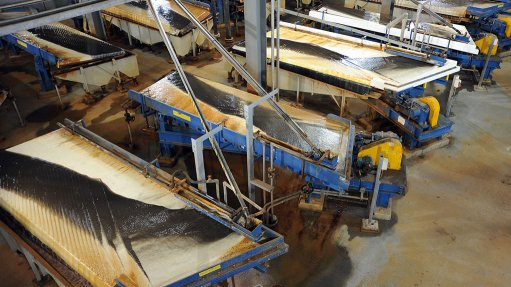
SEPARATING TABLES
Beneficiation plants in South Africa can now make use of magnetically susceptible density tracers to help them improve their mineral processing
Photo by: Bloomberg
Beneficiation plants in South Africa can now make use of magnetically susceptible density tracers provided by technology solutions provider Tenova Mining & Minerals South Africa, helping plants improve their mineral processing.
Density tracers are a standard and inexpensive aid to determine whether dense-media separation (DMS) cyclones and other beneficiation plants that exploit density differentials in processed materials are working to the best of their ability.
Tenova says it is now marketing a full range of magnetically susceptible density tracers, which offer easier recovery over the standard density tracers previously marketed, which were popularly used for performance testing of dense media and diamond recovery plants.
The density tracers are manufactured and marketed by the company’s laboratory in Kempton Park. They have traditionally found widespread application in the diamond processing industry, but are increasingly being used for other commodities – coal, in particular. As a result, Tenova says it has seen the demand for tracers grow in recent years.
The new range of magnetically susceptible density tracers was developed to facilitate recovery of the tracers after passage through plants, as their magnetic nature enables magnets to recover them easily and efficiently from the host material. The tracers are colour-coded according to their specific gravity, as was the case with standard density tracers, for those operations that still prefer to use visual means to recover the individual tracers.
Density tracers simulate density characteristics and particle dimensions of precious stones, such as diamonds and other products such as platinum-group metals, chromite, andalusite, base metals and coal.
The tracers are supplied in the form of cubes, with sizes ranging from 0.8 mm to 20 mm. They are produced as standard over a density range of 1.20 to 4.20, with the most popular density tracer range being 2.70 to 3.53 for diamond processing applications and 1.20 to 2.00 for coal processing. They are applied worldwide in large and small production plants, laboratories and academic research institutions.
Quality control ensures that the tracer particles are an exact size and shape, while their special robust formulation enables many passes through a plant. With regard to size and density, the tolerance limit is 0.1 mm and 0.01 to 0.03 respectively.
Tenova says its laboratory is ISO 9001-compliant and supplies state-of-the-art metallurgical and analytical capability to support the company as well as provide an external service to industry. Its services cover various physical separation tests, such as heavy liquids separation and flotation tests; determination of solids flow characteristics to ensure choke-free design of storage bins, stockpiles and chutes; density tracer manufacture; and water testing capabilities.
Tenova focuses on the provision of total innovative solutions across the full mining and minerals industry value chain in South Africa. The company is an integrated solutions provider to the global mining, bulk materials handling and minerals beneficiation and processing sectors, offering innovative technological solutions and full process and commodity knowledge across the mining industry value chain.